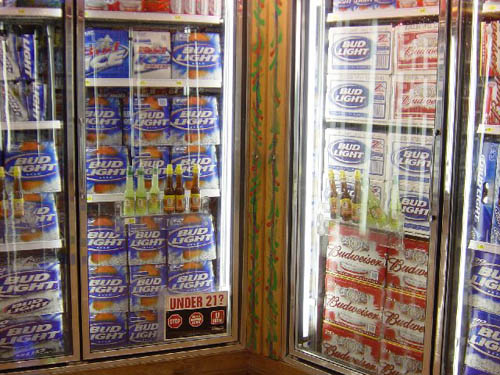|
|
|
|
I am standing in the Phoenix Ranch Market looking at the beer section. Up on my side of town, you would be lucky to find a beer section this big, physically. The refrigerators are floor to ceiling, and they are laid out in a big, loose “C” pattern. There are four doors to my left, four in front of me, and four to my right. All of them are filled with just beer. Not to mention the stack of cardboard twelve packs in front of me, which is almost shoulder height and all beer too. This is a lot of beer. What makes this really interesting is not the quantity of beer here, or even the size of the section all this beer is housed in. What makes it really interesting is the lack of any diversity. Everything else I’ve seen in this store has given the shopper options. Elsewhere in the store you can find 29 kinds of peppers, 71 kinds of candy, fruits that cover the whole spectrum, and cuts of meat that even I have never previously heard of. But here in one of the biggest beer sections I have ever seen, you have two choices of beer. Pilsner, or light lager. Oh sure, there are about 7 or 8 brand names, including Coors, Budweiser, Tecate, Corona, Milwaukee’s Best, Dos Equis, and Miller, but they are all variations on the same style of beer. Even further emphasis seems to be on the light versions of these already light beers. I have to ask myself why. Is it a class distinction? Is beer becoming snooty? Flavour for the upper class, and swill for the lower class? I don’t think so. If there was going to be a class distinction in beer, it would have been in the early 1990’s when the “micro-brews” and “imports” were first on the rise. Now days if you go into a local brewery, you are likely to pay nearly the same price for 15 ounces of tasty fresh beer that you would at any other bar for 12 ounces of Bud light. Further more, it would be almost impossible to exist in the western world without having heard of Guinness or Heineken, and even they really don’t cost substantially more than the regular mass produced flavourless beers. It’s not like wine, where a $200 bottle of Lafite Rothschild cuts a hard class line when compared to a $2 bottle of Boone’s. So in South Phoenix, where is the Fat tire? The Murphy’s and the Beamish? Where are the Singletrack, and the New Castle? Why can’t I get a Stone IPA? Where are the beers of flavour and body? I don’t know, but they are not here. Not in this Market. No browns, no stouts, no porters, No India pale ales, no regular pale ales, no dark lager, no micro-brews, no dark ales, no colour what-so-ever. Is this an indicator of South Phoenix? Is it really an indication of what the people here like to drink? Or is it that they just don’t drink better beer because it isn’t sold here? Is it that the image created over a decade ago has persisted in this area, leaving the masses to think that there is still a class distinction in beer? What are the causes for such a lack of diversity that seems so incongruent with the teaming diversity everywhere else I look? In an area with such racial diversity, architectural diversity, neighbourhood diversity, and a tendency towards bright colour and flavourful food… where’s the beer? Maybe it’s intentional. Perhaps this is the last bastion against gentrification. “You can put nice homes in our neighbourhoods, but you’ll never get us to drink good beer!” I can’t imagine that would be the calling. Oddly, you can get some of these richer tasting beers at the local restaurants. You just can’t buy them at The Phoenix Ranch Market. It makes me wonder if all these new housing developments that are sprouting up all over South Phoenix will bring with them new grocery stores. The new middle class may demand stores that lack the massive produce and meat sections of The Phoenix Ranch Market, but make up for it in a broader diversity of world foods beyond Central American cuisine, and yes, a broader selection of beer. If that happens, will The Phoenix Ranch Market be able to compete? Will it survive the changes as the South Phoenix becomes South Mountain Village? I don’t know, but the beer section could be the indicator. We have read that residential subdivisions in Phoenix lack any kind of identity, they all appear the same. I say that within these cookie-cutter communities there could be hidden gains. They may look alike on the outside, but the insides are quite different. There are foods from more areas of the world, and most importantly, you can get any type or style of beer from any part of the world you want. What will shape the things to come? Will the new South Phoenix middle class be drawn to the colour of The Phoenix Ranch Market and keep it afloat? Only beer will tell.
|
|
| Back to South Phoenix 2005 | |

 Beer
Section Freeze Frame
Beer
Section Freeze Frame